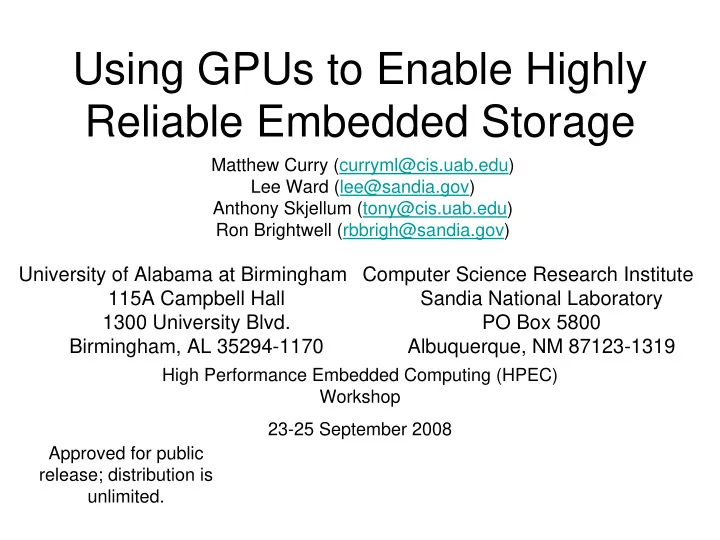

Using GPUs to Enable Highly Reliable Embedded Storage Matthew Curry (curryml@cis.uab.edu) Lee Ward (lee@sandia.gov) Anthony Skjellum (tony@cis.uab.edu) Ron Brightwell (rbbrigh@sandia.gov) University of Alabama at Birmingham Computer Science Research Institute 115A Campbell Hall Sandia National Laboratory 1300 University Blvd. PO Box 5800 Birmingham, AL 35294-1170 Albuquerque, NM 87123-1319 High Performance Embedded Computing (HPEC) Workshop 23-25 September 2008 Approved for public release; distribution is unlimited.
The Storage Reliability Problem • Embedded environments are subject to harsh conditions where normal failure estimates may not apply • Since many embedded systems are purposed for data collection, data integrity is of high priority • Embedded systems often must contain as little hardware as possible (e.g. space applications)
Current Methods of Increasing Reliability • RAID – RAID 1: Mirroring (Two-disk configuration) – RAID 5: Single Parity – RAID 6: Dual Parity • Nested RAID – RAID 1+0: Stripe over multiple RAID 1 sets – RAID 5+0: Stripe over multiple RAID 5 sets – RAID 6+0: Stripe over multiple RAID 6 sets
Current Methods of Increasing Reliability • RAID MTTDL (Mean Time to Data Loss) – RAID 1: MTTF 2 /2 – RAID 5: MTTF 2 /(D*(D-1)) – RAID 6: MTTF 3 /(D*(D-1)*(D-2)) • Nested RAID MTTDL – RAID 1+0: MTTDL(RAID1)/N – RAID 5+0: MTTDL(RAID5)/N – RAID 6+0: MTTDL(RAID6)/N
RAID Reliabliity (1e7 hours MTTF, 24 hours MTTR) 1.00E+19 1.00E+18 1.00E+17 1.00E+16 1.00E+15 1.00E+14 1.00E+13 1.00E+12 RAID N+3 1.00E+11 RAID 6+0 RAID 6 MTTDL 1.00E+10 RAID 1+0 1.00E+09 RAID 5+0 RAID 5 1.00E+08 RAID 0 1.00E+07 1.00E+06 1.00E+05 1.00E+04 1.00E+03 1.00E+02 1.00E+01 1.00E+00 4 5 6 8 10 12 Number of Disks
Why N+3 (Or Higher) Isn’t Done • Hardware RAID solutions largely don’t support it – Known Exception: RAID-TP from Accusys uses three parity disks • Software RAID doesn’t support it – Reed-Solomon coding is CPU intensive and inefficient with CPU memory organization
An Overview of Reed-Solomon Coding • General method of generating arbitrary amounts of parity data for n+m systems • A vector of n data elements is multiplied by an n x m dispersal matrix, yielding m parity elements • Finite field arithmetic
Multiplication Example • {37} = 32 + 4 + 1 = 100101 = x 5 + x 2 + x 0 • Use Linear Shift Feedback Register to multiply an element by {02} x 0 x 1 x 2 x 3 x 4 x 5 x 6 x 7
Multiplication Example • Direct arbitrary multiplication requires distributing so that only addition (XOR) and multiplication by two occur. – {57} x {37} – {57} x ({02} 5 + {02} 2 + {02}) – {57} x {02} 5 + {57} x {02} 2 + {57} x {02} • Potentially dozens of elementary operations!
Optimization: Lookup Tables • Similar to the relationship that holds for real numbers: e log(x)+log(y) = x * y • This relationship translates (almost) directly to finite field arithmetic, with lookup tables for the logarithm and exponentiation operators • Unfortunately, parallel table lookup capabilities aren’t common in commodity processors – Waiting patiently for SSE5
NVIDIA GPU Architecture • GDDR3 Global Memory • 16-30 Multiprocessing Units • One shared 8 KB memory region per multiprocessing unit (16 banks) • Eight cores per multiprocessor
Integrating the GPU
3+3 Performance 1200 1000 800 Throughput (MB/s) 600 3+3 400 200 0 3 2 1 0 9 2 0 8 6 4 2 0 8 6 4 2 0 8 6 4 2 0 2 0 8 6 4 1 2 3 3 1 3 4 6 8 0 2 3 5 7 9 1 2 4 6 8 0 1 3 5 7 9 1 1 1 1 1 1 2 2 2 2 2 3 3 3 3 3 3 Data Size (KB)
29+3 Performance 1500 1480 1460 1440 1420 Throughput (MB/s) 1400 29+3 1380 1360 1340 1320 1300 58 116 174 232 290 348 Data Size (KB)
Neglecting PCI Traffic: 3+3 Throughput (MB/s) 1000 1500 2000 2500 500 0 3 12 21 30 39 12 30 48 66 84 102 120 Data Size (KB) 138 156 174 192 210 228 246 264 282 300 318 336 354 372 390 3+3 (No PCI Traffic)
Conclusion • GPUs are an inexpensive way to increase the speed and reliability of software RAID • By pipelining requests through the GPU, N+3 (and greater) are within reach – Requires minimal hardware investment – Provides greater reliability than available with current hardware solutions – Sustains high throughput compared to modern hard disks
Recommend
More recommend